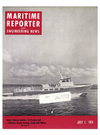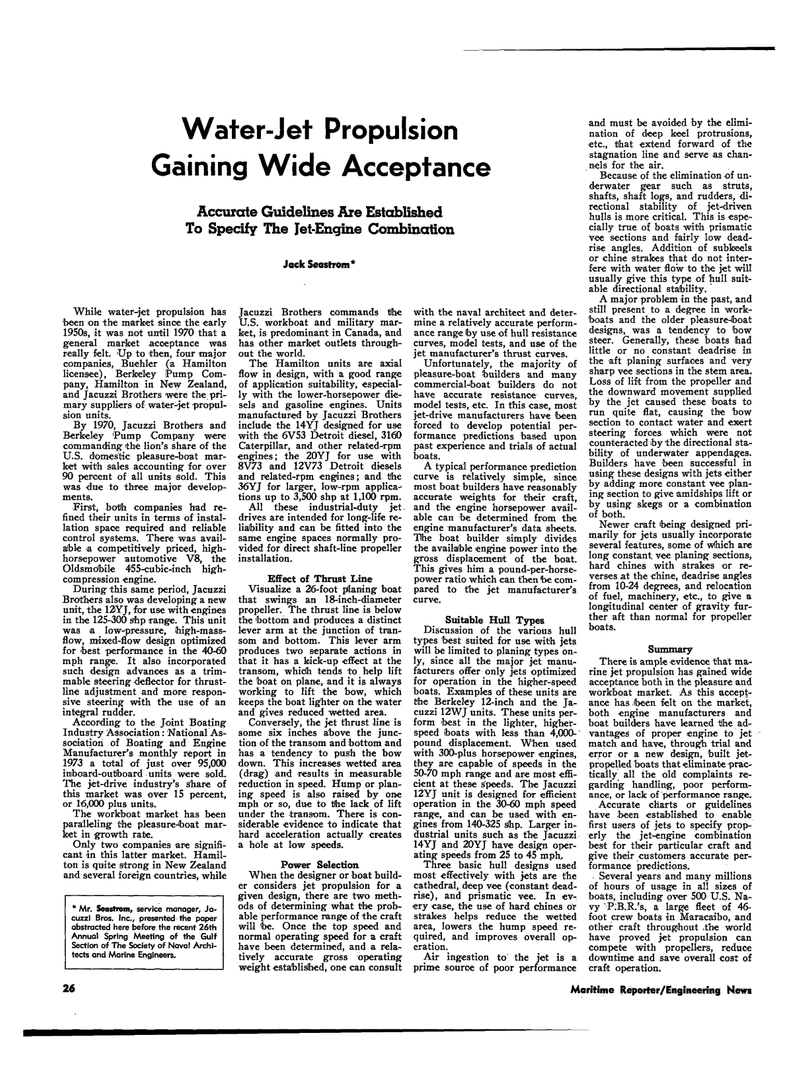
Page 19: of Maritime Reporter Magazine (July 1974)
Read this page in Pdf, Flash or Html5 edition of July 1974 Maritime Reporter Magazine
Water-Jet Propulsion
Gaining Wide Acceptance
Accurate Guidelines Are Established
To Specify The Jet-Engine Combination
While water-jet propulsion has been on the market since the early 1950s, it was not until 1970 that a general market acceptance was really felt. Up to then, four major companies, Buehler (a Hamilton licensee), Berkeley Pump Com- pany, Hamilton in New Zealand, and Jacuzzi Brothers were the pri- mary suppliers of water-jet propul- sion units.
By 1970, Jacuzzi Brothers and
Berkeley Pump Company were commanding the lion's share of the
U.S. domestic pleasure-boat mar- ket -with sales accounting for over 90 percent of all units sold. This was due to three major develop- ments.
First, both companies had re- fined their units in terms of instal- lation space required and reliable control systems. There was avail- able a competitively priced, high- horsepower automotive V8, the
Olds mobile 455-cubic-inch high- compression engine.
During this same period, Jacuzzi
Brothers also was developing a new unit, the 12YJ, for use with engines in the 125-300 slip range. This unit was a low-pressure, ihigh-mass- flow, mixed-flow design optimized for 'best performance in the 40-60 mph range. It also incorporated such design advances as a trim- mable steering deflector for thrust- line adjustment and more respon- sive steering with the use of an integral rudder.
According to the Joint Boating
Industry Association: National As- sociation of Boating and Engine
Manufacturer's monthly report in 1973 a total of just over 95,000 inboard-outboard units were sold.
The jet-drive industry's share of this market was over 15 percent, or 16,000 plus units.
The workboat market has been paralleling the pleasure-boat mar- ket in 'growth rate.
Only two companies are signifi- cant in this latter market. Hamil- ton is quite strong in New Zealand and several foreign countries, while * Mr. Seastrom, service manager, Ja- cuzzi Bros. Inc., presented the paper abstracted here before the recent 26th
Annual Spring Meeting of the Gulf
Section of The Society of Naval Archi- tects and Marine Engineers.
Jack Seastrom*
Jacuzzi Brothers commands the
U.S. workboat and military mar- ket, is predominant in Canada, and has other market outlets through- out the world.
The Hamilton units are axial flow in design, with a good range of application suitability, especial- ly with the lower-horsepower die- sels and gasoline engines. Units manufactured by Jacuzzi Brothers include the 14YJ designed for use with the 6V53 Detroit diesel, 3160
Caterpillar, and other related-rpm engines; the 20YJ for use with 8V73 and 12V73 Detroit diesels and related-rpm engines; and the 36YJ for larger, low-rpm applica- tions up to 3,500 shp at 1,100 rpm.
All these industrial-duty jet drives are intended for long-life re- liability and can be fitted into the same engine spaces normally pro- vided for direct shaft-line propeller installation.
Effect of Thrust Line
Visualize a 26-foot planing boat that swings an 18-inch-diameter propeller. The thrust line is below the 'bottom and produces a distinct lever arm at the junction of tran- som and bottom. This lever arm produces two separate actions in that it has a kick-up effect at the transom, which tends to help lift the boat on plane, and it is always working to lift the bow, which keeps the boat lighter on the water and gives reduced wetted area.
Conversely, the jet thrust line is some six inches above the junc- tion of the transom and bottom and has a tendency to push the bow down. This increases wetted area (drag) and results in measurable reduction in speed. Hump or plan- ing speed is also raised by one mph or so, due to the lack of lift under the transom. There is con- siderable evidence to indicate that hard acceleration actually creates a hole at low speeds.
Power Selection
When the designer or boat build- er considers jet propulsion for a given design, there are two meth- ods of determining what the prob- able performance range of the craft will 'be. Once the top speed and normal operating speed for a craft have been determined, and a rela- tively accurate gross operating weight established, one can consult with the naval architect and deter- mine a relatively accurate perform- ance range by use of hull resistance curves, model tests, and use of the jet manufacturer's thrust curves.
Unfortunately, the majority of pleasure-boat builders and many commercial-boat builders do not have accurate resistance curves, model tests, etc. In this case, most jet-drive manufacturers have been forced to develop potential per- formance predictions based upon past experience and trials of actual boats.
A typical performance prediction curve is relatively simple, since most boat builders have reasonably accurate weights for their craft, and the engine horsepower avail- able can be determined from the engine manufacturer's data sheets.
The boat builder simply divides the available engine power into the gross displacement of the boat.
This gives him a pound-per-horse- power ratio which can then be com- pared to the jet manufacturer's curve.
Suitable Hull Types
Discussion of the various hull types best suited for use with jets will be limited to planing types on- ly, since all the major jet manu- facturers offer only jets optimized for operation in the higher-speed boats. Examples of these units are the Berkeley 12-inch and the Ja- cuzzi 12WJ units. These units per- form best in the lighter, higher- speed boats with less than 4,000- pound displacement. When used with 300-plus horsepower engines, they are capable of speeds in the 50-70 mph range and are most effi- cient at these speeds. The Jacuzzi 12YJ unit is designed for efficient operation in the 30-60 mph speed range, and can be used with en- gines from 140-325 slhp. Larger in- dustrial units such as the Jacuzzi 14YJ and 20YJ have design oper- ating speeds from 25 to 45 mph.
Three basic hull designs used most effectively with jets are the cathedral, deep vee (constant dead- rise), and prismatic vee. In ev- ery case, the use of hard chines Or strakes helps reduce the wetted area, lowers the hump speed re- quired, and improves overall op- eration.
Air ingestion to the jet is a prime source of poor performance and must be avoided by the elimi- nation of deep keel protrusions, etc., that extend forward of the stagnation line and serve as chan- nels for the air.
Because of the elimination of un- derwater gear such as struts, shafts, shaft logs, and rudders, di- rectional stability of jet-driven hulls is more critical. This is espe- cially true of boats with prismatic vee sections and fairly low dead- rise angles. Addition of subkeels or chine strakes that do not inter- fere with water flow to the jet will usually give this type of hull suit- able directional stability.
A major problem in the past, and still present to a degree in work- boats and the older pleasure-boat designs, was a tendency to bow steer. Generally, these boats had little or no constant deadrise in the aft planing surfaces and very sharp vee sections in the stem area.
Loss of lift from the propeller and the downward movement supplied by the jet caused these boats to run quite flat, causing the bow section to contact water and exert steering forces which were not counteracted by the directional sta- bility of underwater appendages.
Builders have been successful in using these designs with jets either by adding more constant vee plan- ing section to give amidships lift or by using skegs or a combination of both.
Newer craft being designed pri- marily for jets usually incorporate several features, some of wihich are long constant, vee planing sections, hard chines with strakes or re- verses at the chine, deadrise angles from 10-24 degrees, and relocation of fuel, machinery, etc., to give a longitudinal center of gravity fur- ther aft than normal for propeller boats.
Summary
There is ample evidence that ma- rine jet propulsion has gained wide acceptance both in the pleasure and workboat market. As this accept- ance has been felt on the market, both engine manufacturers and boat builders have learned the ad- vantages of proper engine to jet match and have, through trial and error or a new design, built jet- propelled boats that eliminate prac- tically all the old complaints re- garding handling, poor perform- ance, or lack of performance range.
Accurate charts or guidelines have .been established to enable first users of jets to specify prop- erly the jet-engine combination best for their particular craft and give their customers accurate per- formance predictions.
Several years and many millions of hours of usage in all sizes of boats, including over 500 U.S. Na- vy ' P:B.R.'s, a large fleet of 46- foot crew boats in Maracaibo, and other craft throughout .the world have proved jet propulsion can compete with propellers, reduce downtime and save overall cost of craft operation. 10
Maritime Reporter/Engineering News

 18
18

 20
20
